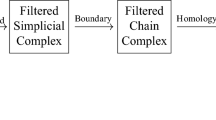Abstract
This article introduces an algorithm to compute the persistent homology of a filtered complex with various coefficient fields in a single matrix reduction. The algorithm is output-sensitive in the total number of distinct persistent homological features in the diagrams for the different coefficient fields. This computation allows us to infer the prime divisors of the torsion coefficients of the integral homology groups of the topological space at any scale, hence furnishing a more informative description of topology than persistence in a single coefficient field. We provide theoretical complexity analysis as well as detailed experimental results. The code is part of the Gudhi software library, and is available at Maria (in: GUDHI User and Reference Manual, GUDHI Editorial Board, 2015).




Similar content being viewed by others
References
Allen, H.: Algebraic Topology, 1st edn. Cambridge University Press, New York (2001)
Bauer, U., Kerber, M., Reininghaus, J.: Clear and compress: computing persistent homology in chunks. Topol. Methods Data Anal. Vis. III, 103–117 (2014)
Bobrowski, O., Kahle, M.: Topology of random geometric complexes: a survey. J. Appl. Comput. Topol. 1, 331–364 (2018)
Boissonnat, J.-D., Maria, C.: Computing persistent homology with various coefficient fields in a single pass. In: Proceedings of 22th Annual European Symposium on Algorithms-ESA 2014, Wroclaw, Poland, September 8–10, 2014, pp. 185–196 (2014)
Boissonnat, J.-D., Dey, T.K., Maria, C.: The compressed annotation matrix: an efficient data structure for computing persistent cohomology. Algorithmica 73(3), 607–619 (2015)
Carlsson, G.E., Ishkhanov, T., de Silva, V., Zomorodian, A.: On the local behavior of spaces of natural images. Int. J. Comput. Vis. 76(1), 1–12 (2008)
Chen, C., Kerber, M.: Persistent homology computation with a twist. In: Proceedings 27th European Workshop on Computational Geometry (2011)
Cohen-Steiner, D., Edelsbrunner, H., Harer, J.: Stability of persistence diagrams. Discret. Comput. Geom. 37(1), 103–120 (2007)
de Silva, V., Morozov, D., Vejdemo-Johansson, M.: Persistent cohomology and circular coordinates. Discret. Comput. Geom. 45(4), 737–759 (2011)
Dey, T.K., Fan, F., Wang, Y.: Computing topological persistence for simplicial maps. In: Symposium on Computational Geometry, p. 345 (2014)
Edelsbrunner, H., Harer, J.: Computational Topology: An Introduction. American Mathematical Society, Providence (2010)
Edelsbrunner, H., Letscher, D., Zomorodian, A.: Topological persistence and simplification. Discret. Comput. Geom. 28(4), 511–533 (2002)
Fürer, M.: Faster integer multiplication. SIAM J. Comput. 39(3), 979–1005 (2009)
Granlund, T.: GMP: the GNU multiple precision arithmetic library. http://gmplib.org/ (2004)
Kahle, M., Lutz, F., Newman, A., Parsons, K.: Cohen–Lenstra heuristics for torsion in homology of random complexes. ArXiv e-prints (2017)
Linial, N., Meshulam, R.: Homological connectivity of random 2-complexes. Combinatorica 26(4), 475–487 (2006)
Linial, N., Peled, Y.: On the phase transition in random simplicial complexes. Ann. Math. 184(3), 745–773 (2016)
Łuczak, T., Peled, Y.: Integral homology of random simplicial complexes. Discret. Comput. Geom. 59(1), 131–142 (2018)
Maria, C.: Persistent cohomology. In: GUDHI User and Reference Manual. GUDHI Editorial Board (2015)
Martin, S., Thompson, A., Coutsias, E.A., Watson, J.: Topology of cyclo-octane energy landscape. J. Chem. Phys. 132(23), 234115 (2010)
Rosser, J.B., Schoenfeld, L.: Approximate formulas for some functions of prime numbers. Ill. J. Math. 6, 64–94 (1962)
Von Zur Gathen, J., Gerhard, J.: Modern Computer Algebra, 2nd edn. Cambridge University Press, New York (2003)
Zomorodian, A., Carlsson, G.E.: Computing persistent homology. Discret. Comput. Geom. 33(2), 249–274 (2005)
Acknowledgements
The research leading to these results has received funding from the European Research Council (ERC) under the European Union’s Seventh Framework Programme (FP/2007-2013)/ERC Grant Agreement No. 339025 GUDHI (Algorithmic Foundations of Geometry Understanding in Higher Dimensions).
Author information
Authors and Affiliations
Corresponding author
Ethics declarations
Conflict of interest
On behalf of all authors, the corresponding author states that there is no conflict of interest.
Additional information
Publisher's Note
Springer Nature remains neutral with regard to jurisdictional claims in published maps and institutional affiliations.
This research has been partially supported by the European Research Council under Advanced Grant 339025 GUDHI (Algorithmic Foundations of Geometric Understanding in Higher Dimensions). An extended abstract of this article appeared in the proceedings of the European Symposium on Algorithms 2014 (Boissonnat and Maria 2014).
Arithmetic notations
Arithmetic notations
-
\(\mathbb {Z}\) ring of integers,
-
\(\mathbb {Z}/n\mathbb {Z}\) ring of integers modulo \(n \ge 2\),
-
\(\mathbb {Q}\) field of rationals,
-
\(q_1, \ldots , q_r\) the r first prime numbers, for \(r \ge 1\),
-
[r] the set \(\{1, \ldots , r\}\),
-
\(Q := q_1 \times \cdots \times q_r\), product of first r prime numbers,
-
\(Q_S := \prod _{s \in S} q_s\), for a subset of indices \(S \subset [r]\),
-
Indices s, t, r, and set of indices S and T, are reserved to the indexing of prime numbers \(\{q_1, \ldots , q_r\}\),
-
Indices i, j, k and m refer to indices in the filtration of a complex, and hence indices for matrix columns and matrix reduction algorithms.
Rights and permissions
About this article
Cite this article
Boissonnat, JD., Maria, C. Computing persistent homology with various coefficient fields in a single pass. J Appl. and Comput. Topology 3, 59–84 (2019). https://doi.org/10.1007/s41468-019-00025-y
Received:
Accepted:
Published:
Issue Date:
DOI: https://doi.org/10.1007/s41468-019-00025-y




